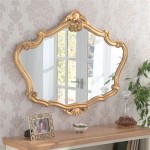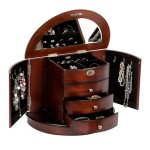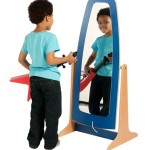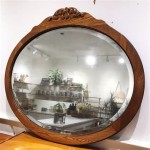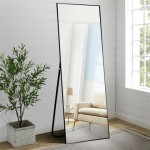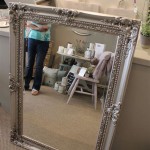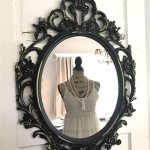How To Replace An Old Medicine Cabinet Mirror
Replacing an old medicine cabinet mirror can significantly improve the aesthetic appeal and functionality of a bathroom. Over time, mirrors can become damaged, discolored, or simply outdated. This article provides a comprehensive guide on how to safely and effectively replace an old medicine cabinet mirror, covering essential tools, preparation steps, and the replacement procedure itself.
Assessing the Existing Mirror and Cabinet
Before commencing the replacement process, a thorough assessment of the existing mirror and cabinet is critical. This involves determining the type of mirror, its dimensions, and the method of attachment. Understanding the existing setup will inform the selection of a suitable replacement and the appropriate tools and techniques required for removal and installation.
Identifying the Mirror Type: Medicine cabinet mirrors typically fall into one of two categories: surface-mounted or recessed. A surface-mounted mirror is attached directly to the cabinet door's exterior, while a recessed mirror is set into a frame or groove. Determining this distinction is crucial because it dictates the removal process. Surface-mounted mirrors are often easier to remove than recessed mirrors, which may require more intricate techniques to detach from the frame.
Measuring the Mirror Dimensions: Accurate measurements are essential for selecting a replacement mirror that fits perfectly. Use a measuring tape to determine the exact width, height, and thickness of the existing mirror. It is advisable to measure multiple times to ensure accuracy. Record these measurements carefully, as they will be used to order the new mirror.
Examining the Attachment Method: Inspect how the mirror is attached to the cabinet door or frame. Common attachment methods include adhesive, clips, screws, or a combination of these. Identifying the attachment method early will help determine the tools needed for removal and prevent accidental damage to the cabinet or surrounding surfaces during the removal process. In some cases, the sealant around the mirror's perimeter may be the primary adhesive, requiring careful softening before attempting removal.
Prior to starting any physical work, it is helpful to take photographs of the existing mirror and its attachment points. These photos can serve as a reference during the reinstallation process, ensuring that the new mirror is positioned and secured correctly.
Gathering Necessary Tools and Materials
Having the right tools and materials readily available is crucial for a smooth and efficient mirror replacement. This step involves assembling everything needed before starting the removal process, minimizing disruptions and potential delays.
Safety Gear: Safety is paramount when working with glass. Essential safety gear includes safety glasses to protect the eyes from flying debris, work gloves to protect hands from sharp edges, and potentially a dust mask to avoid inhaling any particles released during the removal process. Eye and hand protection are non-negotiable when handling glass, preventing potential injuries.
Removal Tools: The specific removal tools required will depend on the mirror's attachment method. Commonly needed tools include a putty knife or scraper to gently pry the mirror away from the adhesive, a heat gun or hair dryer to soften the adhesive, a utility knife to score through caulk or sealant, a screwdriver (Phillips or flathead depending on the screw type), and pliers to remove any stubborn clips.
Cleaning Supplies: Cleaning supplies are essential for preparing the surface for the new mirror. These include a glass cleaner, a clean cloth or paper towels, rubbing alcohol to remove any residual adhesive, and a razor scraper to scrape away any stubborn residue. A clean, smooth surface is necessary for proper adhesion of the replacement mirror.
Installation Materials: Installation materials include the replacement mirror (cut to the correct dimensions), mirror adhesive specifically designed for attaching mirrors to surfaces, double-sided mounting tape for temporary support during adhesive curing, shims or spacers to ensure proper alignment, and caulk or sealant to create a waterproof seal around the perimeter of the mirror. Selecting a high-quality mirror adhesive is essential for long-term adhesion and preventing the mirror from detaching.
Removing the Old Mirror
Removing the old mirror requires a systematic approach, prioritizing safety and minimizing the risk of damage to the cabinet or surrounding surfaces. This process typically involves softening the adhesive, carefully detaching the mirror, and cleaning the surface in preparation for the new mirror.
Softening the Adhesive: If the mirror is attached with adhesive, the first step is to soften the adhesive to facilitate removal. This can be achieved using a heat gun or hair dryer. Apply heat evenly around the perimeter of the mirror, focusing on the edges where the adhesive is located. Keep the heat source moving to avoid overheating any one area. The goal is to soften the adhesive without damaging the cabinet’s finish. Periodically test the mirror's edges with a putty knife to check if the adhesive is softening sufficiently.
Detaching the Mirror: Once the adhesive is softened, carefully insert a putty knife or scraper between the mirror and the cabinet surface. Gently pry the mirror away from the surface, working slowly and methodically around the perimeter. Avoid applying excessive force, as this could cause the mirror to crack or shatter. If resistance is encountered, apply more heat to the area and try again. If the mirror is held in place with clips or screws, remove these before attempting to pry the mirror away from the surface. Screws may be hidden under decorative caps that need to be pried off first.
Handling a Broken Mirror: In the event that the mirror breaks during removal, exercise extreme caution to avoid injury. Wear heavy-duty gloves and use a dustpan and brush to carefully collect the broken pieces. Dispose of the broken glass properly, wrapping it securely in newspaper and placing it in a sturdy container labeled "Broken Glass." Never attempt to pick up broken glass with bare hands.
Cleaning the Surface: After removing the old mirror, thoroughly clean the cabinet surface to remove any residual adhesive, caulk, or debris. Use a razor scraper to carefully scrape away any stubborn residue. Apply rubbing alcohol to a clean cloth and wipe the surface clean to remove any remaining grease or grime. Ensure the surface is completely clean, dry, and smooth before proceeding with the installation of the new mirror. Any imperfections on the surface can affect the adhesion of the new mirror.
Installing the New Mirror
Installing the new mirror requires careful alignment, proper adhesive application, and adequate support during the curing process. This step involves ensuring the mirror is securely attached and properly sealed to prevent moisture damage.
Applying Mirror Adhesive: Apply a generous amount of mirror adhesive to the back of the new mirror. Follow the manufacturer's instructions for application, typically involving applying beads or strips of adhesive evenly across the surface. Avoid applying adhesive too close to the edges of the mirror, as this could cause it to squeeze out when the mirror is pressed against the cabinet surface. Ensure the adhesive is specifically designed for mirrors, as other types of adhesive may damage the mirror's backing.
Positioning and Securing the Mirror: Carefully position the new mirror onto the prepared cabinet surface. Align the mirror precisely, ensuring it is centered and level. Press the mirror firmly against the surface, applying even pressure across the entire surface to ensure good contact with the adhesive. Use double-sided mounting tape to temporarily hold the mirror in place while the adhesive cures. Apply strips of tape vertically across the mirror's surface, ensuring the tape is strong enough to support the mirror's weight. Use shims or spacers to maintain proper alignment and prevent the mirror from sliding during the curing process.
Curing the Adhesive: Allow the adhesive to cure completely according to the manufacturer's instructions. This typically takes 24 to 48 hours. During this time, avoid touching or disturbing the mirror. The mounting tape and shims should remain in place until the adhesive is fully cured. After the curing period, carefully remove the mounting tape and shims. Clean any adhesive residue with a clean cloth and rubbing alcohol.
Sealing the Perimeter: Apply a bead of caulk or sealant around the perimeter of the mirror to create a waterproof seal. Choose a caulk or sealant that is specifically designed for bathroom use and is resistant to mold and mildew. Apply the caulk or sealant evenly, ensuring it fills any gaps between the mirror and the cabinet surface. Smooth the caulk or sealant with a wet finger or a caulking tool to create a clean, professional finish. Allow the caulk or sealant to dry completely before using the medicine cabinet.
Final Inspection and Cleanup
After the mirror is installed and the adhesive and caulk have fully cured, conduct a final inspection to ensure the installation is secure and aesthetically pleasing. This involves checking for any gaps, loose edges, or imperfections and addressing them as needed. Finally, thoroughly clean the mirror and the surrounding area to remove any smudges, fingerprints, or debris.

Diy Niche Shelf Old Bathroom Medicine Cabinet Makeover A Piece Of Rainbow

Medicine Cabinets Ideas 7 Diy Updates Bob Vila

How To Remove A Medicine Cabinet Kay S Place

How To Turn A Mirror Into Medicine Cabinet Diy Bathroom

Frame Update To Medicine Cabinet Atop Serenity Hill Bathroom Mirrors Diy Mirror

How To Install A Medicine Cabinet The Home Depot

Easily Replace An Old Medicine Cabinet Wg Wood S

Medicine Cabinets Ideas 7 Diy Updates Bob Vila

How To Replace A Medicine Cabinet Mirror Doityourself Com

Covering Up An Old Bathroom Medicine Cabinet With A Sliding Mirror

